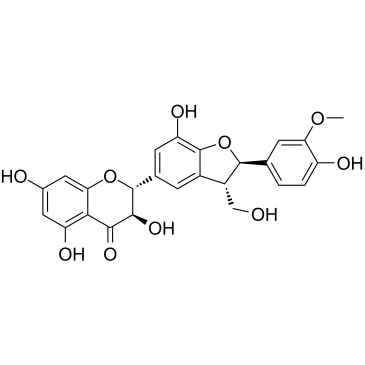Silicristin

Silicristin structure
|
Common Name | Silicristin | ||
|---|---|---|---|---|
| CAS Number | 33889-69-9 | Molecular Weight | 482.436 | |
| Density | 1.6±0.1 g/cm3 | Boiling Point | 782.0±60.0 °C at 760 mmHg | |
| Molecular Formula | C25H22O10 | Melting Point | N/A | |
| MSDS | Chinese USA | Flash Point | 270.5±26.4 °C | |
| Symbol |

GHS07 |
Signal Word | Warning | |
|
Effect of the flavanolignans of Silybum marianum L. on lipid peroxidation in rat liver microsomes and freshly isolated hepatocytes.
Pharmacol. Res. 25(2) , 147-54, (1992) The effect of several flavanolignans (silicristin, silidianin, silybin and isosilybin) present in silymarin, the extract of Silybum marianum fruits, was tested on lipid peroxidation in rat liver microsomes and freshly isolated hepatocytes. In microsomes lipid... |
|
|
Separation and characterization of silybin, isosilybin, silydianin and silychristin in milk thistle extract by liquid chromatography-electrospray tandem mass spectrometry.
J. Chromatogr. A. 1116(1-2) , 57-68, (2006) A selective and sensitive liquid chromatography/tandem mass spectrometry (LC/MS/MS) method has been developed for the characterization of silymarin in commercially available milk thistle extract. In this study, six main active constituents, including silydian... |
|
|
Identifying the differential effects of silymarin constituents on cell growth and cell cycle regulatory molecules in human prostate cancer cells.
Int. J. Cancer 123(1) , 41-50, (2008) Prostate cancer (PCa) is the leading cause of cancer-related deaths in men; urgent measures are warranted to lower this deadly malignancy. Silymarin is a known cancer chemopreventive agent, but the relative anticancer efficacy of its constituents is still unk... |
|
|
Analysis and comparison of active constituents in commercial standardized silymarin extracts by liquid chromatography-electrospray ionization mass spectrometry.
J. Chromatogr. B. Analyt. Technol. Biomed. Life Sci. 845(1) , 95-103, (2007) A sensitive method for the simultaneous quantitation of six active constituents in commercial silymarin standardized extracts was developed based on liquid chromatography (LC) in combination with mass spectrometry (MS). The six main active constituents, namel... |
|
|
Synchronized and sustained release of multiple components in silymarin from erodible glyceryl monostearate matrix system.
Eur. J. Pharm. Biopharm. 66(2) , 210-9, (2007) Development of sustained delivery systems for herbal medicines was very difficult because of their complexity in composition. The concept of synchronized release from sustained release systems, which is characterized by release of multiple components in their... |
|
|
Effect of silybin and its congeners on human liver microsomal cytochrome P450 activities.
Phytother Res. 16(7) , 632-8, (2002) Silybin and related flavonolignans form a major part of the Silybum marianum extract, silymarin, which has been used to treat liver diseases for hundreds of years. Although regarded as safe, many of the extract constituents remain thus far untested for their ... |
|
|
Inhibition of the superoxide anion release and hydrogen peroxide formation in PMNLs by flavonolignans.
Phytother Res. 15(7) , 608-12, (2001) The mixture of flavonolignans [Legalon: silybin (2a), isosilybin (3), silydianin (4) and silychristin (5)] and derivatives of silybin (2b-d) were assessed for their inhibitory activity on the oxidative burst of PMA-stimulated human PMNLs. The inhibitory effec... |
|
|
Topical delivery of silymarin constituents via the skin route.
Acta Pharmacol. Sin. 31(1) , 118-26, (2010) Silibinin (SB), silydianin (SD), and silychristin (SC) are components of silymarin. These compounds can be used to protect the skin from oxidative stress induced by ultraviolet (UV) irradiation and treat it. To this end, the absorption of silymarin constituen... |
|
|
[Bioavailability of silymarin, I: Volumes of distribution of silybin, silydianin, and silychristin from in-vitro data (author's transl)].
Arch. Pharm. (Weinheim) 314(6) , 515-7, (1981)
|
|
|
Influence of exogenous salicylic acid on flavonolignans and lipoxygenase activity in the hairy root cultures of Silybum marianum.
Cell Biol. Int. 33(9) , 988-94, (2009) Silymarin is one of the most potent antioxidant so far developed from plant sources used as hepatoprotectants. Influence of different concentrations (0, 1, 2, 4, 6 and 8mg/50ml culture) and exposure time (24, 48, 72, 96 and 120h) of salicylic acid on lipoxyge... |